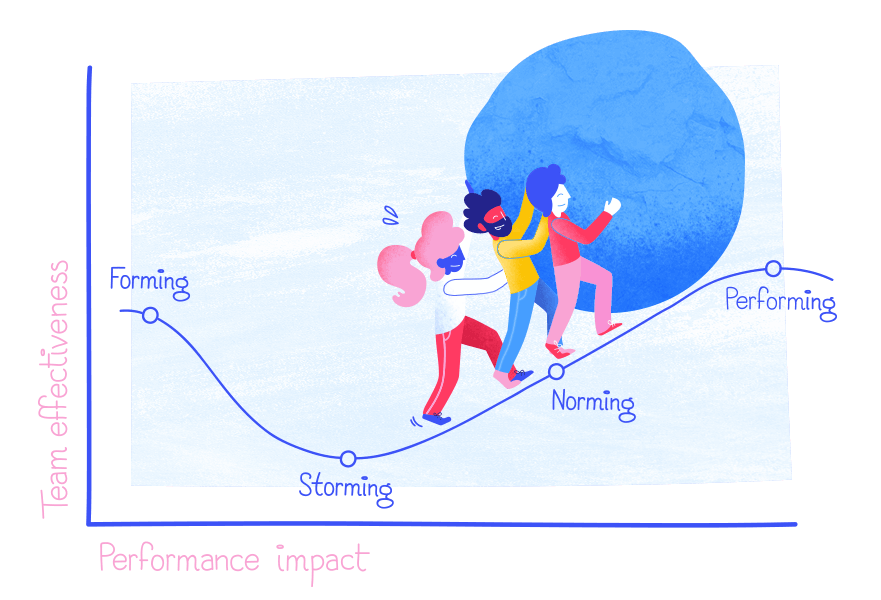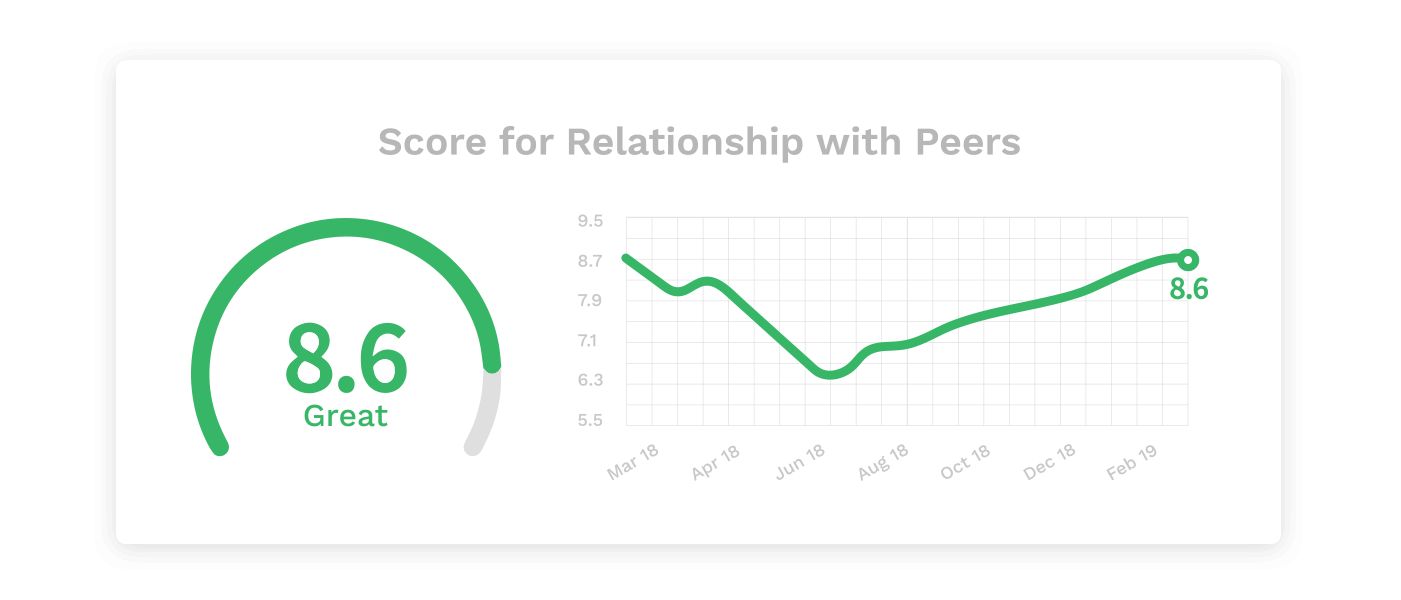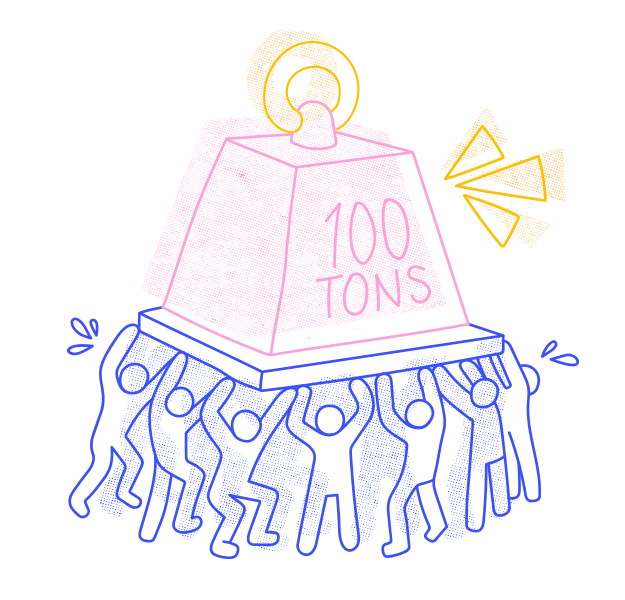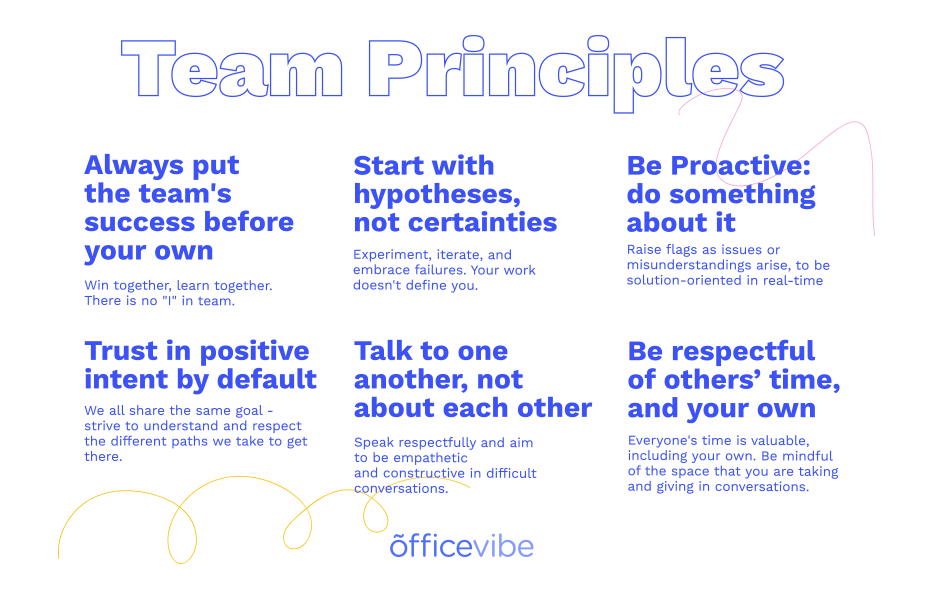We’ve all read articles on the “Top 10 Ways” to improve as a manager or the “5 Must Dos” to be a better leader, but we want to try something different this time.
We’re going to share a difficult experience that we had on our real life team, and the medley of solutions we used to overcome it. It worked for us, and we hope you find something in our method that works for you and your team, too.
Vulnerability is key, right? And we feel that as an organization steadfast on putting people at the center of things, it’s our responsibility to share our learnings with you. And oh, there are many.
Assess your organization’s employee experience in minutes

What's in this article
- So, what happened?
- This is us
- First… The four stages of team development
- T’was a dark & storming month for our high-performing team
- Our manager weathers the storm: “It wasn’t easy…”
- Action time! The Meeting That Saved Our Team
- The calm after the storm
- How to build team principles: a manager’s guide
- Share your story!
So, what happened?
Well, what happens on every team?
Human conflict.
Conflict between colleagues, new employees with new ways of working, fast-paced growth, communication woes, power struggles—the whole shabang—all topped with the bitter-sweet cherry of human complexity.
As a manager, you probably already know that this conflict, the infamous “storming phase,” is an inevitability. It is not a sign that you’re failing as a manager; on the contrary, it’s a normal part of team performance and a consequential time for personal growth and development.
This is us

Team: The Marketing Team at Officevibe
Marketing Director: Marie-Christine Côté (MC)
Languages: 2 (English and French)
Number of Employees: We grew from 5 to 15 employees (& counting) in 1 year
First… The four stages of team development
Take a minute to understand what the phases of development, coined by Dr. Bruce Tuckman, actually look like and reflect on where you think your team is currently at.

Forming
- A team is built, people are getting to know their roles and colleagues
- Team members are polite and focused on their individual tasks
⭐ Proactive Tip: Managers should facilitate relationship building and ensure roles, responsibilities, and expectations are clear during this stage<
Storming
- People get more comfortable and start pushing boundaries
- Symptoms like competition and lack of trust lead to negative attitudes and resistance to working together
⭐ These factors could result in conflict. Don’t worry, it’s normal, and if we pushed through it, you can, too!
Norming
- Differences begin to resolve with the right tools and clarity, and team members learn to work together and appreciate one another’s strengths
- Communication improves, feedback can be given and challenges can be made safely and without animosity
⭐ Things are running pretty smoothly—but there’s always potential to go from good to great.
Performing
- Strategies are in place for resolving conflict, and there’s a sense of safety, loyalty and support on the team
- People work more autonomously with clarity of roles, a shared vision, and shared goals
⭐ This is where you want to be; your workplace utopia
T’was a dark & storming month for our high-performing team
The tension on our team was palpable; you could cut it clean with a bread knife. From the outside, everything seemed normal; we all showed up to work, went through the motions, attended our meetings. But, if you looked closely enough you could see—feel—that something wasn’t quite right.
One employee recounts being in the eye of the storm: “We were no longer in sync. Our team was growing quickly and we experienced the typical growing pains that come with that reality. Swim lanes were blurred, processes were challenged and accountability was unclear. Lack of clarity and communication resulted in frustration, but the frank conversations needed to fix this weren’t being had. It was just too uncomfortable.”
The tangible giveaway was that nothing was being delivered.
Our team effectiveness was in the gutter. We were like dogs chasing their tails; we discussed and challenged ideas in circles, but never found the confidence as a team to make any decisions. Who had the final say anyway? No one was entirely sure at this point, and that was a big problem.
Without trust at the base of things, we tend to process and perceive feedback and questions with a much more skeptical lens; one without positive intent.
We were intelligent individuals working toward the same goals and objectives (often arguing the same points), but emotions can act as blinders to the facts.

Our manager weathers the storm: “It wasn’t easy…”
Here, we ask our manager, MC, how she felt during this time, what she noticed on our team, and how she planned to help us fix it.
How did you know that your team was in the storming phase?
The team’s non-verbal communication was terrible, and there was a lot of tension in meetings, which prevented things from moving forward.
Then I heard about conflicts from individual employees, so I felt like there was a lot on my shoulders, which I knew was not sustainable. If we want to build leaderful teams* (where leadership is shared), people need to be able to talk to each other.
*Leaderful Teams are teams that don’t rely solely on the manager for leadership and direction, and don’t need to. On a leaderful team, everyone takes collective and individual ownership for overcoming challenges, implementing solutions, and achieving goals.
Thankfully, I also had hints in the weekly Officevibe feedback, so I knew how my team was really feeling. And our engagement metric for “Relationship with Peers” was low, which is one of the biggest triggers you can have. The team didn’t feel good with each other. On the other hand, the “Relationship with Manager” metric was high, which is good because people felt they could talk to me. But a manager should never be a bottleneck, they should be an enabler.
Learn more about how to track these metrics on your team using Officevibe here

Here you can see the drop in our “Relationship with Peers” metric, and the steady incline since then. Notice the similarity between this graph and the forming, storming, norming, and performing one?
Why do you think the relationship between peers is so important?
That’s the base…
From a business perspective, if you’re spending 80% of your capacity trying to understand people and how to properly interact with your peers, you only have 20% left for creativity. You have to create together, but if you can’t talk to one another openly, or listen to each other properly, then you’ll never bring ideas to the table.
From a personal perspective, we come to work to develop ourselves, exchange with people, and be a part of something bigger than us. If you’re not getting along with colleagues, it isn’t fun coming to work, and it definitely isn’t fun working for a team when nothing is being delivered. Ultimately, people want to have an impact.
How did all this affect you as a manager? As a person?
It wasn’t easy. I couldn’t sleep at night; it was a really stressful feeling that the team wasn’t engaged. We had very aggressive objectives, which is ok, but it’s so hard when the trouble is human problems; it’s difficult to have the conversations that need to be had.
I came to work early, read up on emotional intelligence, team performance, spoke to coaches within the organization, and my own manager, who prompted some good reflection.
My biggest fear was that my team would become cynical and that my manager would doubt me. I felt unequipped as this was something I hadn’t necessarily lived yet as a first-time manager. But I was learning along the way.
Where did you start to fix things?
My coach gave me the four stages of team performance to read, so I quickly realized that our team couldn’t perform like an all-star team if we didn’t go through all the four stages. It reassured me that it was normal for us to be here, and when I shared this with the team, it reassured them as well.
Then I worked with a few members of the team to plan an offsite where we could tackle the issues we were having, together.

Action time! The Meeting That Saved Our Team
The role of manager is tricky because there’s only so much they can actually do for their employees. What they can do is create an atmosphere that is enabling, safe and motivating for their employees to want to put in the work to solve it on their own.
Our manager nailed it. Below are the steps we took to exit the storming phase.
1. Get out of the office
We planned a full-day offsite. It was time to get away from the office, out of the bubble. Taking a proverbial step back while also stepping outside of the space of conflict and tension. Neutral territory, if you will.
2. Build empathy and inclusion
You want to build lines of trust between people not just in relation to work, but based on personal experiences. If you know where someone is coming from you’ll be way more open to them.
MC
On a timeline, we all started by sharing the year we were born, revealing the variation in ages we have on the team. Then we began to build up empathy. We were each asked to add three impactful life moments to the timeline.
The stories we heard were real and raw, some of personal experiences and losses, others that were professional in nature. We all became a little more enlightened about our colleagues that day.
3. Educate and reflect
Having an external reading allowed us to speak more openly about ourselves by looking at it in relation to another team at another company. It helped not make it too personal right away. We eased in.
MC
Next, we read a portion from the book The Loyalist Team to learn about the different team types. By reading the case studies and scenarios presented in the book, we were able to reflect on the current state of our own team, and ourselves as contributors.
It gave us a good benchmark as to where we were at—and really shed light on the team that we weren’t.
4. Take a team assessment
If we weren’t yet a Loyalist team, what were we? To find out, we each took the assessment assigned by the book. The insights and introspection from this exercise really helped us have a more holistic view of where we were at, and kick off something we had all been avoiding for way too long: a real conversation.
5. Talk about it
We went around the table and shared our insights, which eased us in to what eventually became an open and honest discussion. Being able to reference the book instead of ourselves made it easier for people to talk about our situation.
This exercise brought out frustrations, which is good. For example, the notion of ‘challenging ideas’ came up a lot. It made people feel they didn’t have credibility in their expertise, so we discussed how to challenge each other respectfully by seeking to understand someone’s perspective before giving your own. This turns it from questioning into affirming.
MC
6. Create team norms
Just like most organizations have a culture fueled by a set of values, every team likewise has its own subculture. This means that teams need to create their own governing set of values unique to them.
Without team norms, there is sure to be conflict. For example, I might think that arriving late to a meeting is unacceptable, but another person maybe doesn’t think it’s that big of a deal. This means we are starting from bases of work that aren’t the same, with different triggers.
MC
These norms, or “Team Principles,” are not for the manager to dictate, they’re for the team to build as a unit, so they can see themselves represented in them, creating a sense of shared accountability.
Example: 🐘 Call out the elephant in the room — Communicating challenges, issues and conflicts to one another is for the betterment of the team. Call out what’s causing discomfort, then and there.

The calm after the storm
Not even a week after this meeting we began to see a difference. The impact it had was amazing.
MC
Finally, we started to call out problems and discomfort on the spot instead of letting issues fester. The “Call out the elephant in the room” principle made it our shared responsibility to confront conflict head on. And so we did.
Working with this courage and transparency brought such great results it became addictive and palpable in the best way. Other teams in the company picked up on our vibe, and began to create their own principles.
Just like that, our team conflict became a success story.
How to build team principles: a manager’s guide
- Give everyone time individually (to avoid groupthink) to reflect on what they feel the most important team norms should be.
- One by one, let everyone share what principles they believe should be implemented, and why.
- Create post-it clusters of recurring ideas to surface the pain points.
- Together, choose and agree on the principles that everyone feels best fit the current landscape of the team.
- Have a subgroup put them together in the team’s voice and tone with more descriptive action points. For example: Embrace the mindset of feedback as a conversation, not a confrontation.
- Finally, have them printed and hung up as a visual reminder.
- Explain the team principles at the onboarding stage for new employees.
- After a few months, check in with the team on whether they are still using the principles or if it’s time to revisit them. You can use a custom poll for individual feedback with Officevibe, or hold a group meeting.
- Repeat! As the team changes and the storm settles on the horizon, do the process again.
Share your story!
We’re all in this together. If you would like to share your team story, please reach out at content@officevibe.com.
A previous version of this page was published on April 18, 2017.
Equip HR and managers with tools to engage, recognize, and drive performance.




